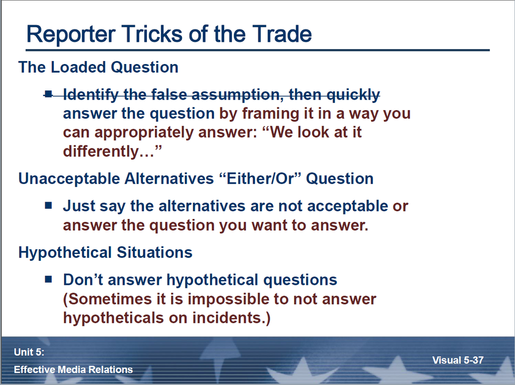|
Teaching with a PowerPoint built by someone else (especially a committee) is a great opportunity to inspire student and instructor boredom. In the incident response world, we are usually bound by NWCG and FEMA developed presentations. Not only can they be dry, but they are often out of date and not aligned with the frequent changes in incident management and crisis communications/public information. So what's an instructor to do? Well, I change the slides. You can see from this L-952 All-Hazards PIO slide, I kept the FEMA language, but crossed out what I didn't agree with. I also added stuff in a different color that I felt was important for the students to know. The first allows the students to see the original course info and the strike-through prompts me to explain why I don't like the FEMA answer. The second prompts a discussion of my views and how those may contrast with the official words.
In the first bullet, I would argue that if you identify the false assumption, you're repeating it into the mic or notepad and you never know how things will be edited. If you're live, you don't want to give credence to the false assumption by acknowledging it or repeating it. Best to cut it off, search for the underlying question, and answer that one to the best of your ability. For the second bullet, I debated about striking out the FEMA stuff, but left it unadorned. Still, I would likely refrain from saying the alternatives are not acceptable. I'd ignore the either/or part, pick the part of the question that is most relevant, and build an answer around that. I'd also try to frame the answer so that if the reporter followed-up, they would need to craft a more functional question. A recent post on dealing with uncertainty includes a bit about hypotheticals on incidents and covers what I would bring up in class. Making PPoints interesting and engaging takes a lot of effort beforehand. I'll go through every slide and often change some just based on the student experiences, knowledge, agency, expectations, or anything else that might affect the learning environment. (Of course, if I could wholly create my own materials, the slide would not be so wordy to begin with.) The approach of strike-throughs and add-ons works for me, but every individual has a different style, so find your own path. Just make sure the students aren't drowsily doodling on their handouts while you're instructing. Keep it moving, ask lots of questions, and look for every opportunity to create discussion and promote sharing. Instructing is great fun! And like on any incident, if you're not learning something new every time you teach, you should be. There's a reason the motto of this blog is docendo disco, scribendo cogito, which means "learn by teaching, think by writing." See you in class. _____ JIM Copyright © Jim Whittington, 2018, All rights reserved. Academic use approved with notification and attribution.
0 Comments
Leave a Reply. |
Occasional thoughts on incident response, crisis communications, wildland fire, and other topics.
Docendo disco, scribendo cogito. Blog DOB: 4/26/2018Copyright © Jim Whittington, 2019. Archives
August 2019
Categories
All
|

 RSS Feed
RSS Feed